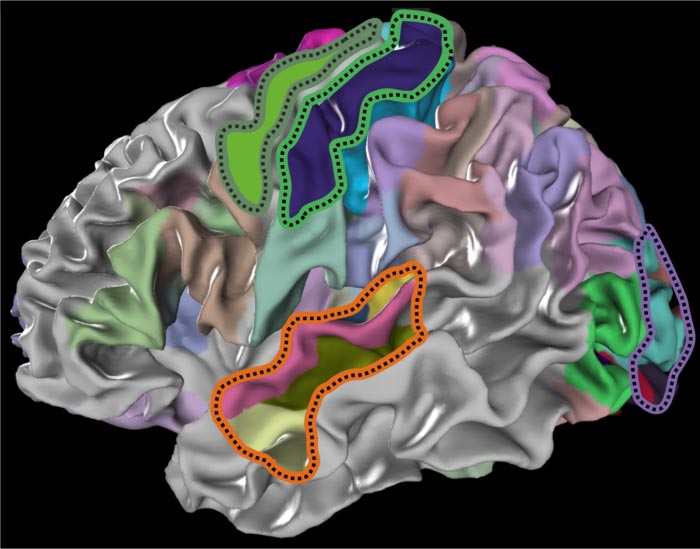Scientists shed new light on human brain organization

The analyzed areas: visual system (purple line), auditory (orange) and motor area (dark grey), and the somatosensory area (green line)
Credit: D. Zachlod, Julich Brain Atlas
Specific cellular, molecular and gene expression patterns in brain areas are linked to function, but their precise relationships remain largely unknown. New findings by scientists at the Human Brain Project (HBP) shed light on these relationships and enable a more comprehensive understanding of human brain organisation.
The HBP researchers conducted a study that targeted three levels of cortical organisation: cytoarchitecture, neurotransmitter receptor architecture and neurotransmitter receptor gene expression. The study elucidates principles of human brain organisation across the visual, auditory, somatosensory and motor functional systems, going beyond the simplified view of a ‘mosaic’ of areas forming the neocortex. The results were published in the journal NeuroImage.
To reveal the different properties of functional systems, and how brain areas within a functional system differ with respect to the processing hierarchy – from primary to higher associative, the team analysed cytoarchitectonic and receptorarchitectonic data of the Julich Brain Atlas – a three-dimensional multimodal atlas of the human brain – and compared the data with transcriptomic data from the Allen Human Brain Atlas.
“Bridging the gaps between different levels of brain organisation is one of the biggest challenges in neuroscience today. In the Julich Brain Atlas we can do it systematically. It integrates the data and is an invaluable tool”, says Daniel Zachlod, first author of the study.
The researchers investigated the relationship of neurotransmitter receptor densities with their corresponding genes in 15 cytoarchitectonic areas of the visual, auditory, somatosensory and motor systems. They analysed differential gene expression within brain areas of each of those functional systems.
“We found that the receptor architecture and gene expression patterns within a functional system change in a systematic way, in correspondence to increasing complexity of information processing”, explains HBP Scientific Director Katrin Amunts, who is last author of the study.
The study demonstrates a method to unravel structure-function relationships by using the multilevel Julich-Brain Atlas to bridge the different scales of brain organisation.
Previous studies had already indicated the relevancy of receptor gene expression for the functional differentiation of the brain in rodents, but data on the human brain is much sparser and more fragmented. The authors of the present study argue that it is mandatory to extend such studies to the human brain, in order to better understand the healthy brain, as well as pathogenesis of brain disorders with alterations in neurotransmitter systems.
Text by Helen Mendes
Further reading:
May 5
HBP researchers identify six new brain areas involved in memory, language and music processing
April 11
Probabilistic maps of four new brain areas now accessible on EBRAINS
April 1
Cellular structure of the human metathalamus revealed in novel 3D map
Journal: NeuroImage
DOI: 10.1016/j.neuroimage.2022.119286
Article Title: Combined analysis of cytoarchitectonic, molecular and transcriptomic patterns reveal differences in brain organization across human functional brain systems.
Article Publication Date: 26-May-2022
Media Contact
Peter Zekert
Human Brain Project
p.zekert@fz-juelich.de
Office: 49-246-161-96860
All latest news from the category: Life Sciences and Chemistry
Articles and reports from the Life Sciences and chemistry area deal with applied and basic research into modern biology, chemistry and human medicine.
Valuable information can be found on a range of life sciences fields including bacteriology, biochemistry, bionics, bioinformatics, biophysics, biotechnology, genetics, geobotany, human biology, marine biology, microbiology, molecular biology, cellular biology, zoology, bioinorganic chemistry, microchemistry and environmental chemistry.
Newest articles

Innovative 3D printed scaffolds offer new hope for bone healing
Researchers at the Institute for Bioengineering of Catalonia have developed novel 3D printed PLA-CaP scaffolds that promote blood vessel formation, ensuring better healing and regeneration of bone tissue. Bone is…

The surprising role of gut infection in Alzheimer’s disease
ASU- and Banner Alzheimer’s Institute-led study implicates link between a common virus and the disease, which travels from the gut to the brain and may be a target for antiviral…

Molecular gardening: New enzymes discovered for protein modification pruning
How deubiquitinases USP53 and USP54 cleave long polyubiquitin chains and how the former is linked to liver disease in children. Deubiquitinases (DUBs) are enzymes used by cells to trim protein…



